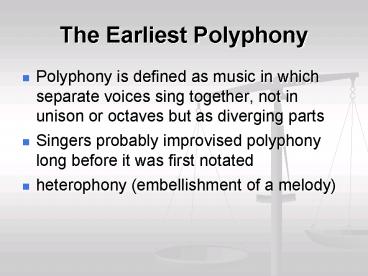The Earliest Polyphony PowerPoint PPT Presentation
1 / 22
Title: The Earliest Polyphony
1
The Earliest Polyphony
- Polyphony is defined as music in which separate
voices sing together, not in unison or octaves
but as diverging parts - Singers probably improvised polyphony long before
it was first notated - heterophony (embellishment of a melody)
2
Musica enchiriadis (Music Handbook)
- ninth century
- Paired with Scolica enchiriadis
- Describes two types of early organum
3
Organum
- Parallel motion Duplication of a plainsong
melody (vox principalis) a perfect fourth or
fifth below by an organal voice (vox organalis)
with duplication of either voice at the octave
possible - Oblique motion The organal voice remaining on
the same pitch in order to avoid tritones against
the principal voice
4
Eleventh-Century Organum
- Micrologus of Guido of Arezzo (ca. 10251028)
voices converge at the ends of phrases from a
third to a unison - Vox organalis usually sings above the vox
principalis - The two voice parts often cross
- Perfect consonances (unison, octave, fourth, and
fifth) favored other intervals occur
incidentally and infrequently
5
The Winchester Troper
- earliest known practical source (i.e., not a
treatise) but its voices are notated in
unheighted neumes without staff lines, so that
only pieces that also occur in later manuscripts
can be reconstructed - Soloists sang polyphony during parts of the Mass
and Divine Office that normally would have been
sung by soloists in plainchant
6
NAWM 13, Alleluia. Justus ut palma, ca. 1100
- Polyphony is mostly note-against-note
- Both contrary and parallel motion are used
- Organal voice sometimes crosses below chant
melody - Cadences resolve either from a third to a unison
or from a sixth to an octave
7
Florid organum (organum duplum, organum purum)
- Chant melody
- Sung in long notes
- Tenor voice that sustains or holds the chant
- Organal voice
- Florid melody
- Many notes for each note of the chant melody
- Rhythm not indicated by notation
8
Discant organum
- note-against-note texture
9
Organum Texts
- Tropes of the Benedicamus Domino
- Sequences
- Versus
- NAWM 14, Jubilemus, exultemus
10
Notre Dame Polyphony
- Paris was a flourishing commercial and
intellectual center in the late twelfth and
thirteenth centuries - Notre Dame Cathedral was the employer of the two
earliest named composers of polyphony, Léonin and
Pérotin - Six rhythmic (modes) patterns were indicated
byligature patterns of neumes
11
Léonin
- Magnus Liber Organi (Great Book of Organum)
- Organum settings of solo portions of responsorial
chants for Mass and Office
12
NAWM 15b, Alleluia. Pascha nostrum
- First Alleluia, in organum purum, for soloists
- Unmeasured rhythm
- Second Alleluia, in unison, by choir
- Psalm verse, "Pascha nostrum" in organum purum
- Clausula (clause or phrase in discant style)
- Discant style used for melismatic portions of the
chant - Substitutions of clausulae were common, so these
passages may have been composed by later composers
13
Pérotin's Organum Compositions
- updated the Magnus Liber Organi
- Used measured rhythm in upper voice against
sustained tenor notes instead of organum purum - Substitute clausulae by Pérotin
- Triple and Quadruple Organum (three-voice and
four-voice organum, respectively)
14
NAWM 16, Sederunt
15
Music of the Thirteenth Century
- Polyphonic Conductus
- Composed by Pérotin and others in the early
thirteenth century Metrical Latin poems - All voices sing the same words in a homophonic
texture - Sometimes melismatic passages (caudae) were
placed before and after - Tenor melody was usually newly composed rather
than coming from chant
16
NAWM 17, Ave virgo virginum
- Three strophes with strophic text setting
- All the voices sing the words
- The rhythm suggests Mode I but Mode II is also
possible
17
The Early Motet (to about 1280)
- Clausulae came to be separable pieces
- At first the words were Latin tropes of the tenor
text - Tenor melodies (cantus firmus)
- Second voice from the bottom motetus
- Third voice from the bottom triplum
- Fourth voice from the bottom quadruplum
- NAWM 18
18
The Franconian Motet
- Franco of Cologne
- Theorist active from ca. 1250 to 1280
- Ars Cantus Mensurabilis, ca. 1280
- treatise on rhythm based on the shape of the notes
19
NAWM 18, Amours mi font / En mai / Flos filius
eius
- Tenor performs the chant melody twice (repeat
marked by ) - Motetus
- Originally a clausula duplum
- French text added later
- Triplum
- Moves at a faster rate than the motetus voice
- Melody was probably original composition, not
from clausula - Independent from the motetus voice
20
The Petronian Motet
- Petrus de Cruce (Pierre de la Croix), active ca.
1270 to 1300 - The triplum voice contains up to six semibreves
to the breve, a much faster pace than in the
Franconian
21
Hocket (hiccup)
- Thirteenth- and fourteenth-century technique in
which rests interrupt the melody, and a different
voice sings the missing
22
Franco's Ars cantus mensurabilis
- written ca. 1280, explains advances in notation
- Allows division of the breve into two or three
semibreves - Choirbook format
- Each voice has its own section on the page

